Fly Fishing for Florida Bluegill
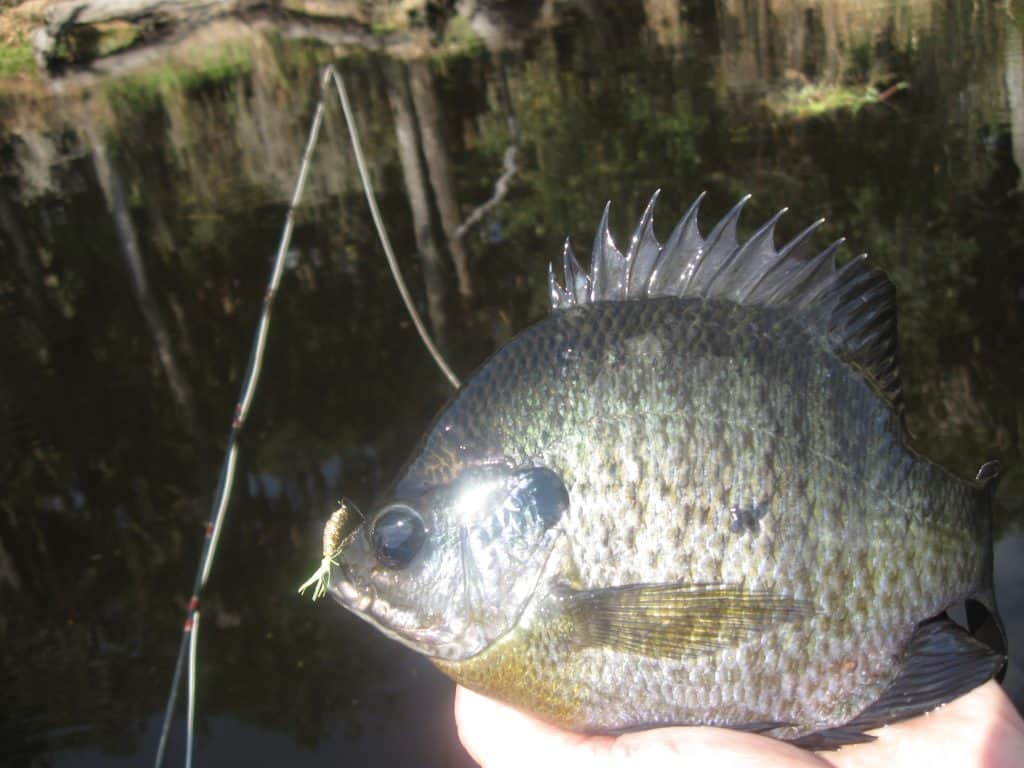
The subject of this post will be fly fishing for Florida bluegill. Freshwater fishing in Florida is very popular, and while largemouth bass get a lot of publicity, the reality is that more anglers pursue bluegill (and other Florida panfish) than any other species. The environment in Florida is perfect and bluegill thrive and just about every freshwater lake or river.
My name is Capt. Jim Klopfer and I have been a fishing guide in Florida since 1991. As I near retirement I find the peacefulness and solitude of freshwater fishing to become more and more appealing. While largemouth bass are great fun to chase on fly, there’s something about bluegill fishing that I especially enjoy.
I offer anglers bluegill fly fishing charters in Florida.
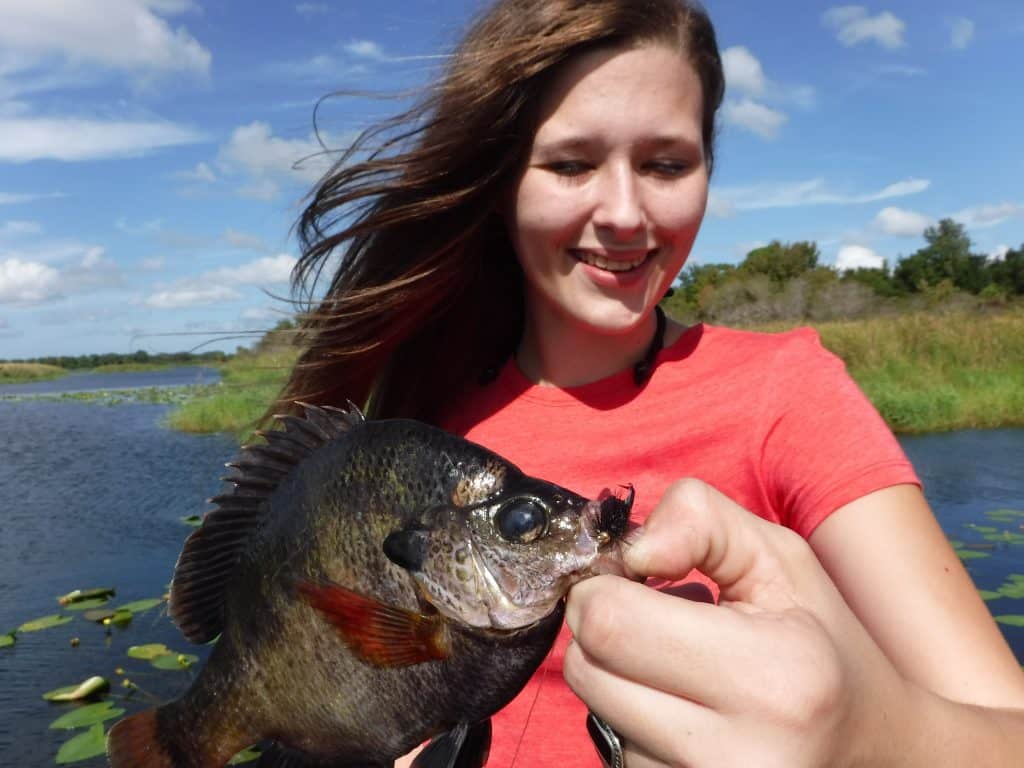
Bluegill are fantastic little game fish when caught on appropriate tackle. Obviously, due to their diminutive size, anglers should use light fly gear. Bluegill are an excellent species to target when fly fishing in Florida. They are numerous, aggressive, widely available, and fun without being overly challenging. For anglers pursuing a meal, they are fantastic eating as well!
Fly fishing for Florida bluegill
Most of the tips and techniques shared in this article on fly fishing for Florida bluegill will apply to other areas of the country. However, there are some differences as well. The primary differences are that bluegill in Florida are almost always caught quite shallow. Many of the lakes have water that is no deeper than 6 feet in the middle. Another factor is the abundance of aquatic vegetation, Florida waters have a lot of weeds!
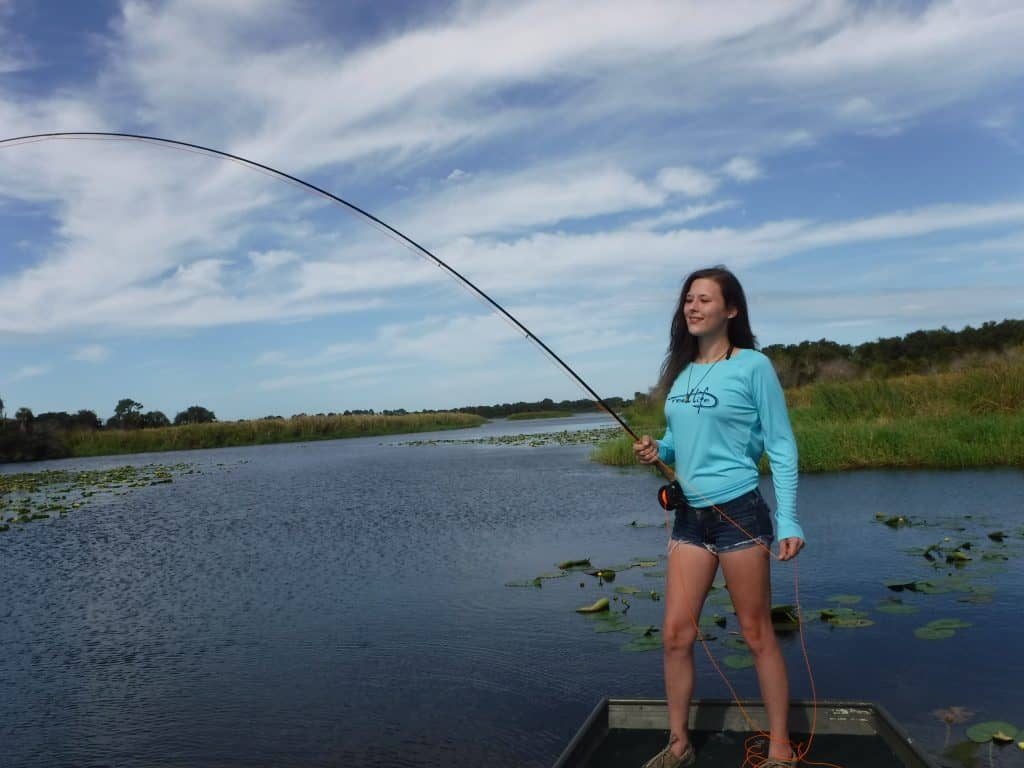
One of the great attractions of fly fishing for bluegill in Florida and anywhere else is the simplicity. Anglers can enjoy many hours of fun very simple and inexpensive tackle. In many cases, a boat is not even required, though one certainly opens up more opportunities. Also, great casting skill is not required. In fact, bluegill are an excellent species to learn how to fly fish on.
Florida bluegill fly fishing tackle and flies
The basic tackle required to fly fish for bluegill certainly need not be complicated. When fly fishing for bluegill in Florida, I like to use a 9 foot 4wt rod with a floating line. The reason I go to a 4wt as opposed to something lighter is that there is always a chance to hook a decent sized bass or other species. The slightly heavier rod gives anglers a fighting chance with a big fish while still keeping bluegill nice and sporty.
Due to the fact that the vast majority of bluegill fishing in Florida is not quite shallow water, anglers need nothing more than a floating line. A 5x tapered leader is fine for most bluegill and panfish applications. Anglers can certainly bump up to a 4x leader if bass are plentiful or the water is stained. Many of the Florida waters are dark and tannin stained, negating the need for a thin leader.
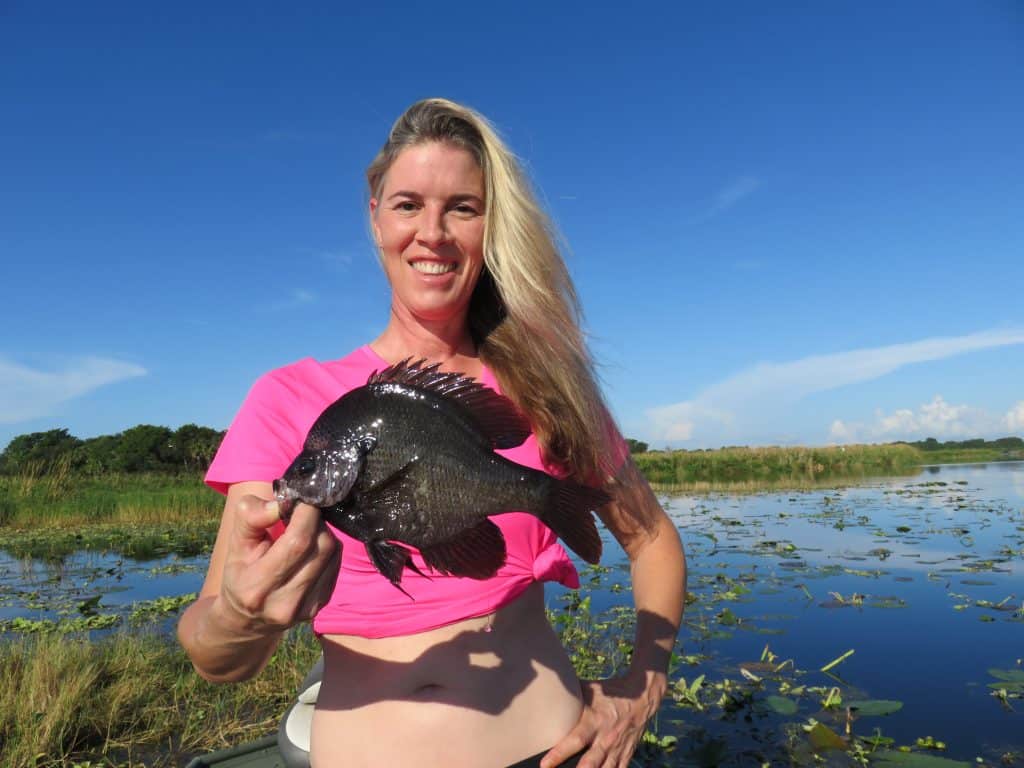
Bluegill are certainly not fussy when it comes to flies, I like freshwater trout and some other species. I use three basic flies when fly fishing for bluegill in Florida. These are a surface flies such as a popper or sponge rubber spider, and epoxy minnow pattern, and some type of woolly bugger or variation. These really are the only flies that an angler will need to have success chasing bluegill and other panfish.
I almost always start off with a surface fly, unless conditions such as a severe cold front dictate otherwise. A small popper with rubber band legs or a small sponge rubber spider are excellent choices. Color really does not matter much. I use a small epoxy minnow pattern quite often with great success. My favorite color combination is gold with a chartreuse tail. Finally, when bluegill are a little bit deeper or a bit finicky, I will slow down and go deeper with a black woolly bugger.
Bluegill fly fishing techniques
I am not getting it into fly casting instruction in this post. There are a ton of great resources both in print form and on video were anglers can easily learn to cast the 15 feet or so required to catch bluegill. Again, as stated earlier, one of the attractions to fly fishing for bluegill is the fact that experience and great fly fishing skills are not needed in order to be successful.
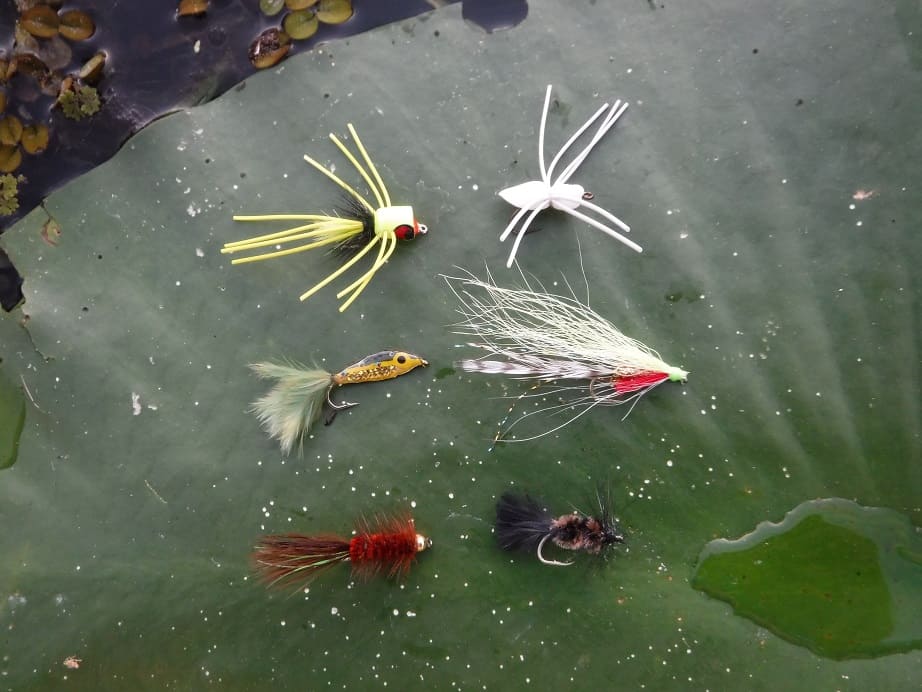
In most cases, bluegill will be found around some type of cover. This can be natural cover such as vegetation as well as man-made cover including boat docks. Bluegill love would and fallen trees should always be concentrated on. No matter where an angler is fly fishing for bluegill in Florida, the techniques and flies are pretty universal.
Once a spot is chosen, the angler ties on a fly and begins to fish. One difference with fly fishing is that when has a very substantial effect. It is always best to have the wind from the back over the casting shoulder, which for most people will be the right side. If no wind is present, I will often drift along. If it is a tad breezy, I will use an anchor to keep the boat stationary.
Retrieving the fly for Florida bluegill
The fly is cast out likely fish holding cover. In Florida, this is often times the edge of some type of vegetation such as lily pads, reads, or other types of grass. Hydro will very often be found below the surface. When using surface flies such as poppers and bugs, it is important not to work the fly to quickly. After the initial cast, can be twitched sharply but subtly and then allowed to set for a fairly extended period of time. It is amazing how long a popper or top water fly will sit motionless before a bluegill takes it.
After the initial cast, the surface fly is twitched several more times. There is no need to work a surface fly all the way back in. Most takes will occur after the first two or three twitches. If a fish does not take the fly, it can be cast out to another spot a few feet away and the process is repeated.
The epoxy minnow fly that I like is worked a little bit more aggressively. This allows anglers to cover more water as well as attracting more active fish. It also catches plenty of bass. The fly is cast out, allowed to sink several seconds, then retrieved back in using 6 to 10 inch strips. It is important to pause between the strips hover motionless. The fly can be worked all the way back in and then recast if no take occurs.
The wooly bugger and other sinking flies are work similarly to the epoxy minnow, but quite a bit more slowly. It is important to have the fly near the bottom, but not be snagging on weeds and other debris. Short little 4 inch to six-inch strips are best again keeping the fly down deep. Bluegill will often take these types of flies on the initial fall, anglers should be alert to this.
Catching bluegill on the “popper dropper”
There is another option that I will employ when fly fishing for bluegill that can increase the odds for success, though it can be a bit trickier to cast. This is what is known as the “popper dropper”. A popper is tied onto the end of the leader and then a 16 inch to 20 inch piece of thin tippet is tied to the bend in the hook of the popper. A small unweighted subsurface fly is then tied on to the other end of the leader.
The popper suspends the submerged fly 18 inches or so below the surface. With each twitch of the popper, subsurface fly jumps up sharply and then flutters down seductively. This can be a very effective technique. Strikes are easily detected as the popper in effect becomes a float, giving anglers a visual signal when a take occurs.
I like to use the strip set method when fly fishing for bluegill in Florida and most other species as well. When retrieving the fly I have my rod tip low near the water surface and in line with the fly line. When a bluegill takes, I pulled sharply with my stripping hand engaging the hook in the fishes mouth. Once I feel it on, I smoothly raise the rod tip up. Smaller fish can be stripped in, which will be the most common situation. A large bass or other fish may get the angler on the reel where it can be fought that way.
Best times to fly fish for Florida bluegill
Florida bluegill spawn in the summer time. This is a time of year were anglers will find concentrations of large bluegill on beds in shallow water. These are easily seen in clear water as areas of many beds which look a little bit like craters. While guarding the nest, mail bluegills are extremely aggressive and will readily take just about any fly cast into the midst. The few days before the full moon from May through September can offer fantastic fishing.
Bluegill are available on fly the rest of the year as well. It doesn’t get very cold in Florida and certainly doesn’t stay that way very long. In the cooler months, angler should avoid fishing the day or two right after a cold front moves through. This will result in strong Northeast winds and cloudless skies. After several days the wind will switch east, it will start to warm up, and the bluegill will be on the bite again.
It would be impossible to list all the productive bluegill fishing waters in Florida. I base my Florida freshwater fishing charters out of the Inverness, Florida area. I fish Lake Panasoffkee and the Withlacoochee River most often. The river gives anglers solace from the wind while Lake Panasoffkee is one of the premier panfish lakes in Florida. Lake Talquin, Lake Okeechobee, Lake Istokpoga, Lake Toho, and the St Johns River are just a few other excellent bluegill fishing waters in Florida. The reality is that most of the lakes that have decent bass populations of excellent bluegill fishing as well.
In conclusion, this article on fly fishing for Florida bluegill will encourage anglers to give this type of fishing a try when visiting the Sunshine State!